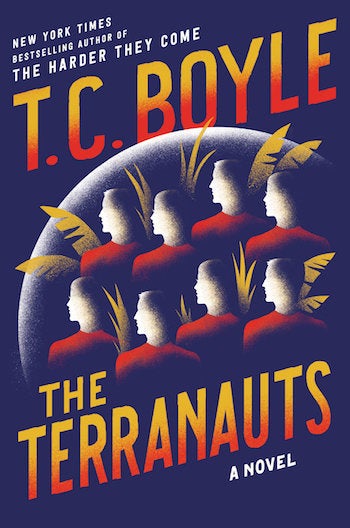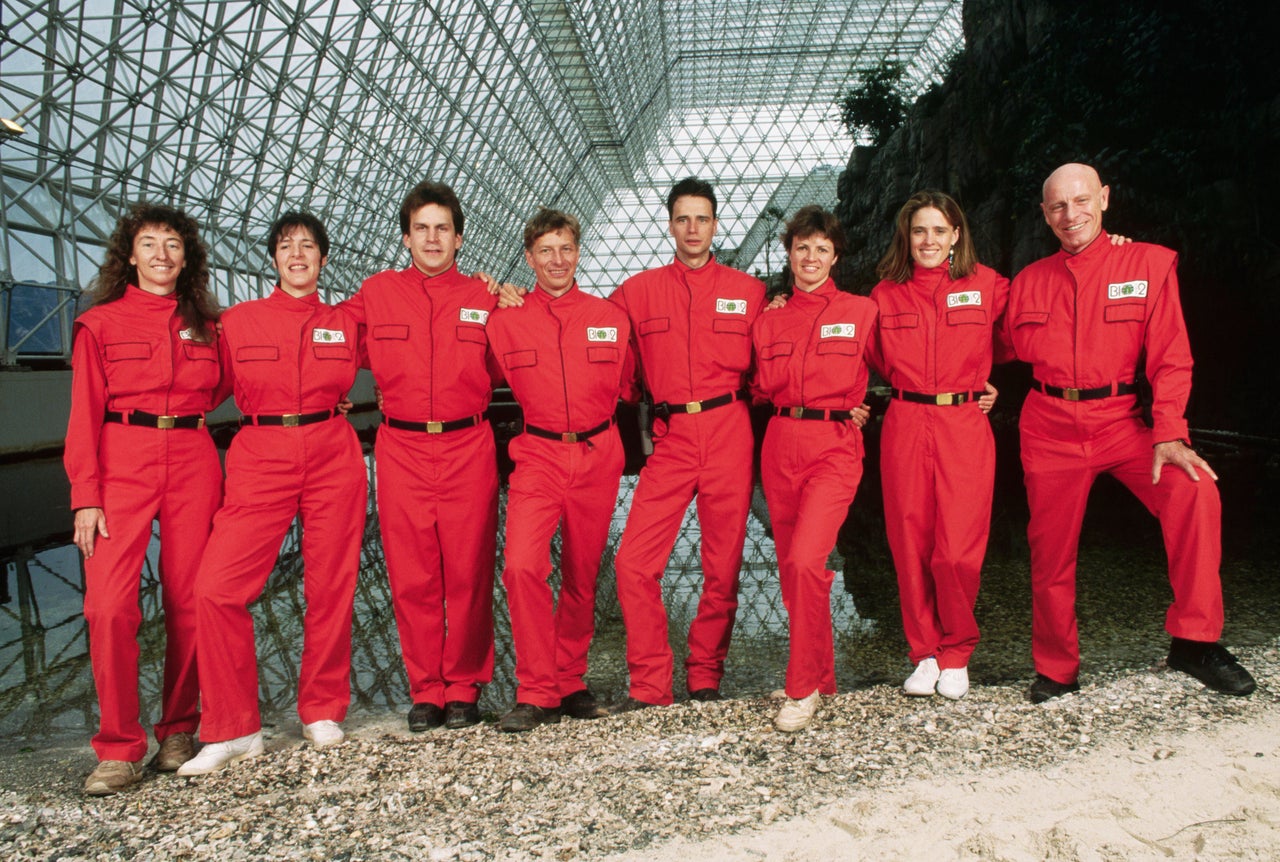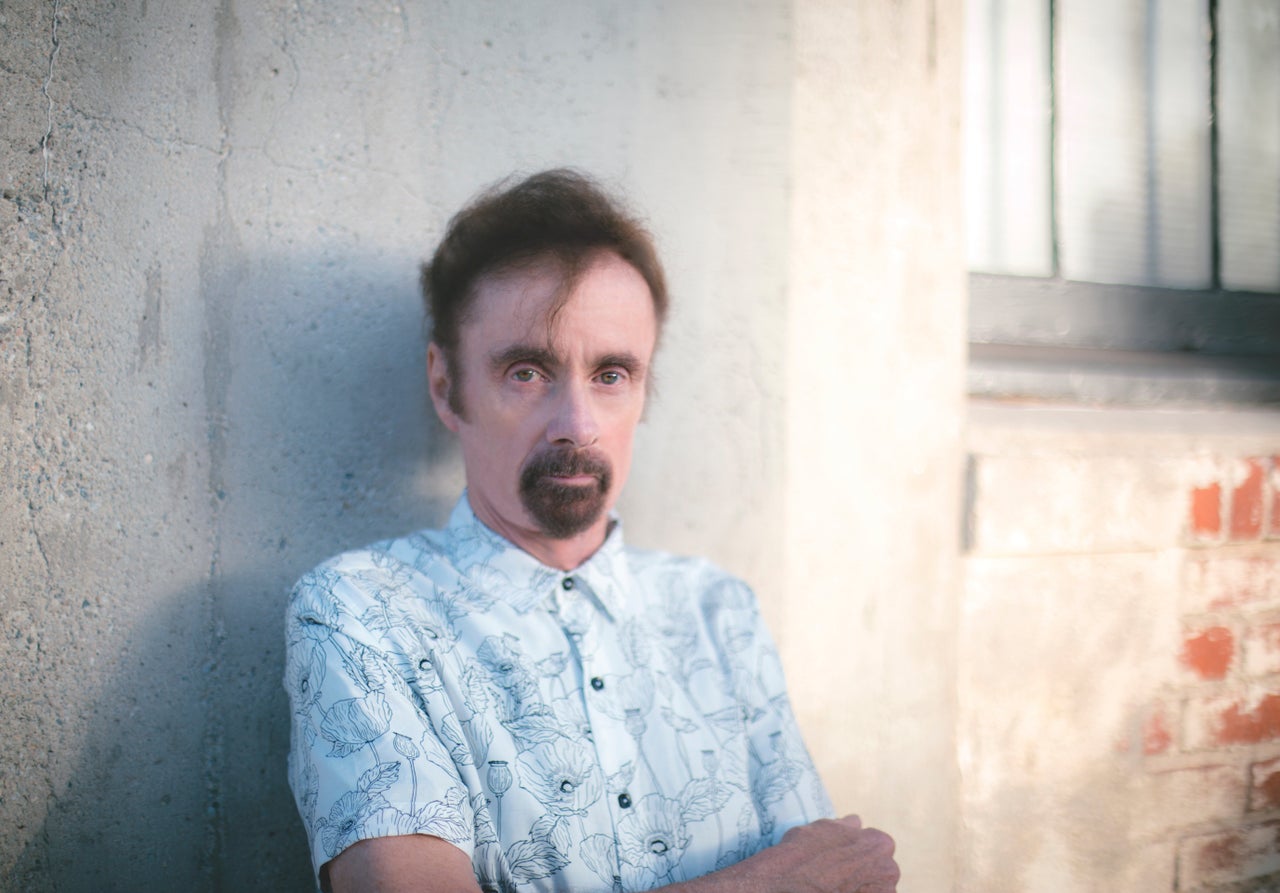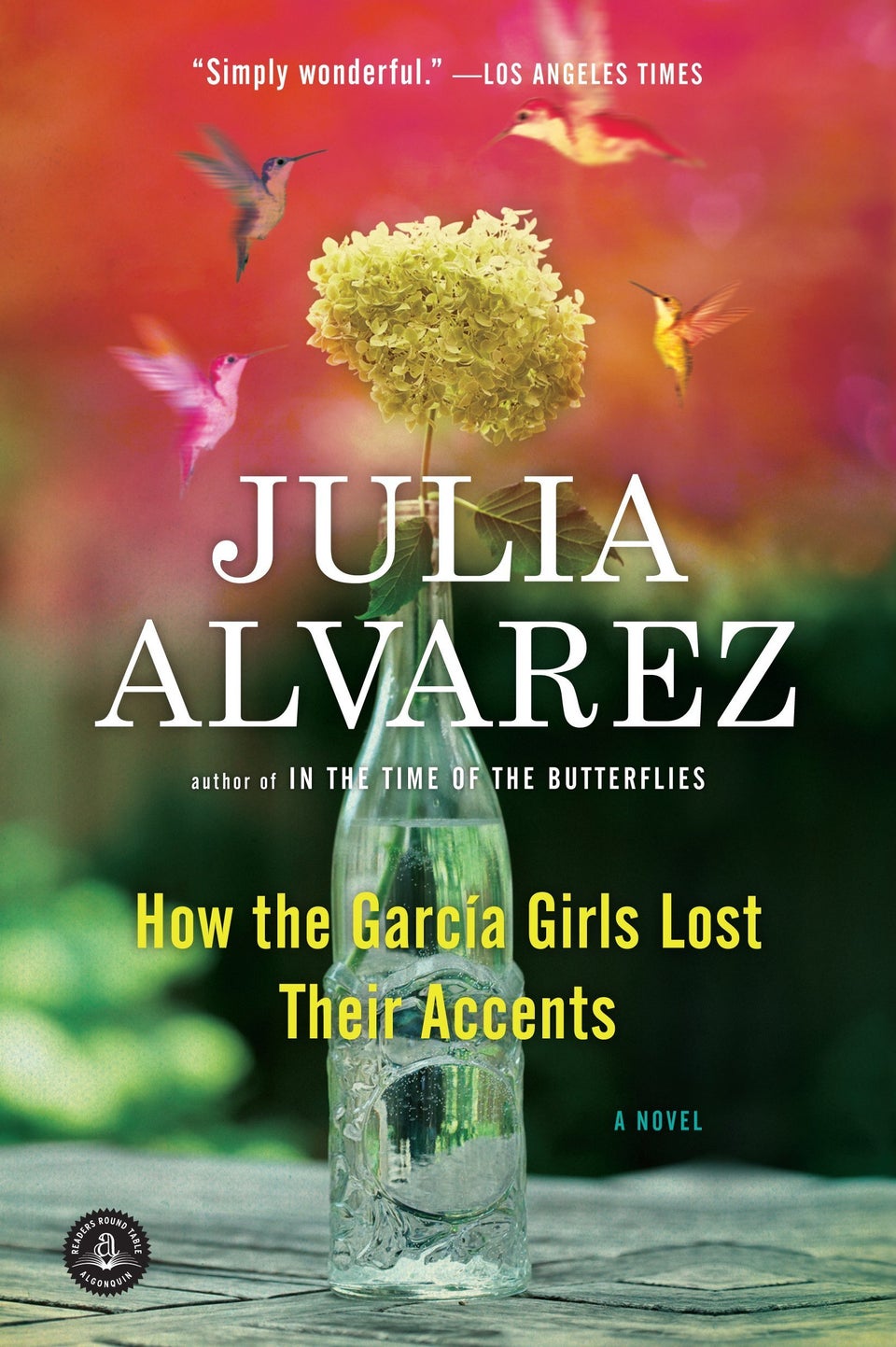Eight people ― four men, four women ― locked in a paradise under glass for two years. No one and nothing is allowed in or out. The world is watching.
In 2016, this sounds like the setup for a no-holds-barred reality show. But in the early 1990s, Biosphere 2 was a real and at least somewhat scientific venture. Built by an idealistic team including inventor John Allen and billionaire backer Ed Bass, the glassed-in enclosure held five biomes, allowing eight adults to subsist on the agricultural output and oxygen within. The concept: to create a totally self-sufficient, enclosed biosphere in which humans could survive without external intervention for two years. (Next stop: colonies on Mars!)
In reality, the project fell short of its lofty goals. Just 12 days into the experiment, one crew member had to leave for several hours for emergency medical treatment beyond the capacity of the team’s lone doctor. By the second year, oxygen and other supplies were being sent in with relative frequency. A second team sent in for another two-year mission only lasted a few months before the whole organization dissolved.
Author T.C. Boyle wanted a do-over. Boyle, who’s previously taken on health sanitariums (The Road to Wellville), utopian communes (Drop City), sex research (The Inner Circle) and more, has a penchant for exploring odd corners of recent history, so the Biosphere debacle was a logical choice ― and he had a vision for it.
“I wanted a kind of revisionist way,” he told The Huffington Post in a phone conversation about his new novel, The Terranauts, “where Ramsay Roothorp says, you know, ‘I would kill somebody rather than break closure.’ I mean, what if they were on Mars?”
In Boyle’s take, rakish bad boy Ramsay, along with fellow Terranaut Dawn Chapman and support crew member Linda Ryu, narrates a fictional Biospheresque mission, Ecosphere 2. No mere need for antibiotics or an oxygen infusion will scuttle the mission in The Terranauts, a mission to which the three narrators profess a cultish devotion. The human appetites of the crew, however, might be more of a problem. Dawn, beautiful and high-minded, throws herself into her role inside the enclosure. Meanwhile, her best friend, Linda, nurses a growing bitterness that she was passed over for the final eight sent inside. And Ramsay? He’s not ready to be celibate for two years just because he’s locked away from all but four of the world’s women.
As the narrative winds on, food runs perilously low, morale flags, and Boyle leaves readers questioning what hope we can take from these experiments in enclosed living for our own swiftly heating planet. In a chat about The Terranauts, Boyle spoke with HuffPost about cults, climate change, and the horrors of living in a tightly closed system:

You have this amazing gift for finding really cool subjects to fictionalize, and deeply researching them and fleshing them out. When and how did you decide to write a book drawing on these Biosphere experiments, and what drew you to them as a subject?
Thanks, first of all, for the compliment! Yes, I pride myself on doing something different each time out. I think that’s what an artist is supposed to do, to keep himself interested and the audience, too. And really I’m just exploring things. I never go into any book or story with an agenda. I just want to find out about things, and more and more as I look back on my career and books, it has to do primarily with the environment and even more in terms of cosmology and who we are and what we’re doing here as animals on this planet.
So the Biosphere 2 experiment was first undertaken in 1991-93. It was a huge deal. As in my books, these Biospherians (I call them Terranauts in my fictional version) were really quite famous. I mean, they were on the cover of all the magazines. They sort of aped NASA’s jumpsuits. I was intrigued and I clipped out everything from the newspapers and thought, man, I’ve gotta write about this. But as you know, within 12 days one of the original Biospherians severely cut the tip of her finger to the point where she might have lost it. One of them is always a doctor, of course, and he sewed it up. But nonetheless, they had to break closure for five hours, and she went to the hospital ― only five hours ― and came back in.
So in the public’s mind ― and I am part of the public, I’m sorry ― that kind of blew its legitimacy, or the theatricality of it, because [...] there was theater attached to it. It was very much a stunt, as well as trying to be science. And again, was it really science? Science says, we will experiment; here is our theory ― let’s see if it’s true or not. They didn’t do that. They were more like, hey kids, let’s put on a show! Let’s enclose ourselves with 3,800 plants and animals for two years and see what happens. Could we survive? Can we do it? What would the oxygen and CO2 levels be, etcetera? So, it was dismissed, and NASA withdrew from it, as sort of a crackpot thing. And yet, looking back, I think it really was a great thing to do.

You returned to this over 20 years after the original experiments took place. Why now? Do you think there’s a particular resonance at this point?
Yeah, I think there is, because the idea doesn’t die. There’s all this talk about Mars missions now. NASA, as you may know, this year just ended a one-year closure of six men and women in the Mauna Loa crater in Hawaii. They were sealed in, but they were allowed to go outside in space suits, just to kind of simulate what it would be like in an alien environment.
So this is ongoing. And of course, as the environment hurtles toward collapse with global warming, overpopulation, species extinction and all the other stuff I write about, this idea becomes more and more in the public eye. On the other hand, as you see in the novel, it is also exclusionary. So it’s gonna save eight Terranauts, what about the rest of us, right? [...] All of that is going into the public’s imagination about what such a Biosphere could do for us.
So when it comes to a character like Linda, she’s really bitter that she wasn’t accepted into the mission. But is she also, in a way, a proxy for those of us who would be left on the outside if Ecosphere 2 became the only way to survive on the planet?
I like your positing that. I suppose so. But more my interest here, as you can see, is in a cult, you know? You’re part of a cult. There are 16 of you. You train together, you believe in nothing beyond this, and you’re excluded. How do you feel? It’s as simple as that. And also, since we have three first-person narrators, it enables me ― I mean, I can talk about this in retrospect, but at the time it’s just happening when I’m writing it ― it gives us an outside view of what’s going on inside, through the glass.
So for those reasons, I really wanted to focus on Linda. I think she’s a very real character in this, and yes, she can represent those of us who are going to be excluded from this sort of salvatory Biosphere, but, on the other hand, excluded from anything. Anything that we really desperately wanted, and someone was chosen above us. [...] It’s just human to want something so passionately.
In the acknowledgements you mentioned that you had consulted some accounts written by the original Biospherians. How much of your group dynamics were drawn from what they wrote about, and how much just came out of your head?
The group dynamic has not so much to do with the actual Biospherians, although they did have their internal conflicts, but also the literature of closed systems ― you know, Six Months in Antarctica, where you’ve got 30 people locked in. It’s just very interesting psychologically, this kind of closed system with different personalities and what happens and how it emerges. I was inspired by what actually happened to them, of course, interpersonally, but really I created totally different characters. I mean, it’s not a roman à clef at all. I didn’t know these people. I just invented characters. It suits my purposes more. I’ve never come out of a journalistic tradition. I’m an artist. I make stories.
But as far as the characters, the original Biospherians, three of them wrote books ― two books. And then there’s a reader’s book about the whole thing, and John Allen, the guy who created it, and so on. Those books are fascinating. And as it turned out, there was a kind of internecine war going on in here between two couples. The other four we don’t know. And they all had agreed, according to these books, not to reveal anything sexual. Of course, as I began to write this book I realized, wait a minute. This is sexy stuff! What are they going to do in there, four men and four women locked in there for two years?

Another source that kept coming to mind was there are a lot of literary references. The theatrical reenactments that God the Creator [the charismatic inventor behind Ecosphere 2] keeps having the crew perform ― for example, Sartre’s “No Exit” ― seem to reference their situation; they use a system for keeping order that’s drawn from Lord of the Flies. Were any of these works on your mind when you worked on The Terranauts?
Sure, absolutely. But again, I have to say, I work intuitively as a novelist. You look at my work and it’s very tightly structured and it does come out pretty much in one draft. I’m constantly rewriting, but it’s basically one draft. Somehow, part of the magic of doing fiction and why I love it so much, is your subconscious mind figures out these problems, particularly structural problems, as you go along.
So as this happens, connections occur to you. You find out what the things are, and why you’re writing it, and where it’s going, and you follow it. And so yes, of course ― the original Biospherians did come out of a theatrical group as well. John Allen insisted that was a big part of what they were doing, so I figured I could replicate that in my telling. [Ed. note: Allen formed a theatrical company with his students in New York in 1968 before moving with his followers to New Mexico to set up a commune called Synergia Ranch. After Allen met Ed Bass, an immensely wealthy oil heir, the group began to work on more ambitious projects with Bass’s backing, culminating in Biosphere 2.]
As far as things like Lord of the Flies, this is just part of our cultural history, I guess, and it’s just there in my brain somewhere, as I’m sure it’s in your brain. And this is an appropriate time to adduce it, and remember it and think about it.
The backdrop of your story came a great deal from the actual science of the Biosphere and this complicated scientific system. Meanwhile, the narrative itself is very close in on these three characters who are very human and very raw. How did you manage stepping from character and writing in the voices of three different people without blending them into each other or taking sides with one, or turning one into a cartoon? Because each narrator is so fully developed.
I’m just doing what comes natural. It comes in sequence. I never wrote out of sequence. I wouldn’t dream of writing just Dawn first, and then the others. It all goes in sequence, as part of the locked-in structure that reveals itself to me.
My last book, The Harder They Come, is in third person. It also has three points of view, two men and a woman, and they do alternate, and I’ve done this before. Many novelists do it. It’s a natural way to tell a story. Here though, I was experimenting with trying to do it from a first-person narrator ― three first-person narrators. And I think it worked out for me because each of them is prejudicial, and we have their testimony, and their testimony sometimes conflicts with what the others are saying. Each has a very distinct character. I think as that developed, it enabled me to play them off one another, in a way that even in third person would have not been I think quite as engaging for the reader.
By the way, have you been to the Biosphere?
No, I never have.
Where do you live?
Now I live in New York, and I’m from Indiana.
Ah, well, if you’re ever taking a trip out West, and happen to be over in the Tucson area, check it out. The architecture alone is so fascinating.
What they did, the original Biospherians, it took a lot of chutzpah. It wasn’t a government thing, everything else ― NASA ― is a government thing. This was just individuals. You got your friendly billionaire, you got your creative genius, and there it is ― and your cult and your committed ecologists. My telling is based closely on the real Biosphere, of course [...] but I wanted to change the names, and I wanted to call it an Ecosphere, etcetera, because I didn’t want to step on their toes. I’m using the real history. But they had the five biomes. You know, it seems to me it would make much more sense ecologically, if they just had one biome ― let’s say, the Florida Everglades. What if they took every creature and everything from there and just had that suite of creatures and plants? Wouldn’t that make more sense, because that all evolved together? But no, it’s a mix-and-match world that they’re creating. So they throw the galagos in for amusement, and they have plants and animals from all over the world. [Ed. note: Often known as bushbabies, galagos are native to continental Africa.]
So what’s fascinating is, if it had worked, and if it had kept going for the 100 years that were proposed, imagine what it would be like in there. It would be a complete evolutionary hothouse in which things would have evolved in ways we could never have imagined. And further, what if you had 10 friendly billionaires, and within a mile of each they built 10 Ecospheres and put whatever mix-and-match animals they wanted? Each one would be a completely and entirely different world! So maybe it’s not real science, but it’s fascinating what they did accomplish.

I think it was Ramsay who voiced that thought in the book, but you stuck so closely to the history instead of exploring that in a fictional way. Were you tempted to explore what could have happened if any of those theoreticals had been done instead?
I guess we’ll have to save that for the sequel! I’ve never written a sequel, so I don’t think it’s going to happen. But yeah, this is pretty fascinating too, in terms of sequels, because the novel has been bought for a TV series, which is wonderful. I’m not going to be involved, but I love the idea of getting the word out to the audiences. The reason it’s attractive to them is it could go on forever. I’m just positing a second closure, but, as you can see at the end, we already know some of the characters who’re going to be in on the third one.
I’m just doing a what-if kind of scenario. What if there were a second and a third and a fourth closure? What might it have been like? And don’t forget, in the real history, the Biospherians did come out after two years. And they closed it again. But it all broke down after six months, because the billionaire had a fight with the creator, and that was the end of that. The thing still exists, you can tour it and see it, but it’ll never be closed again. So I just wondered, what if it were? And of course, anything is possible. I could have jumped ahead to the 99th closure. That would really be sci-fi. Imagine the changes in terms of these plants and animals that would have occurred in 100 years. That really wasn’t the scope of this book. This book was for me to imagine what would happen next if this real Biosphere hadn’t broken down.
And again, it brings up all the questions we talked about earlier of human survival and our chutzpah in trying to create a new world. Elizabeth Kolbert, who I love, writes about ecology for The New Yorker. When NASA did their closure last year, which we were referring to earlier, she wrote a little article about it, and pointed out, from an evolutionary standpoint, how incredible this biosphere is, the one we’re living in ― Biosphere I. How astonishing it is, how it evolved over these eons, and how very very hard it would be to even come close to replicating anything like it anywhere else. And she pointed out, as an environmentalist, that maybe we shouldn’t be thinking so much about these exclusionary little domes on Mars, or wherever, and should be thinking a little harder about solving some of these problems that are plaguing the biosphere that we know.
There were some points in the book, for example, when the generator goes down and the heat starts rising in the Ecosphere. That really gave me pause, thinking about what it would be like if the Earth had some sort of runaway temperature situation, which is likely to happen at some point.
It’s happening now! We’re living in it. The Biosphere and the Ecosphere were good because they really were a kind of accelerator of climate change, as you see from the book. When the power goes, I mean, immediately, the CO2 goes up and the oxygen drops, and the water recycling, it all is happening within days, whereas here it might take months or years or centuries. So in that sense, yeah, it provides drama, but it also provides a kind of microcosm of the larger world and what the problems might be. The electricity goes out; they are in deep, deep trouble. And then they would have to break closure.
There is an irony there, too, that they are pretending ― especially in my version ― they are pretending to be on another planet and beyond reach of anybody but Mission Control, but in fact they could simply break open that airlock.
It was also hard for me to separate the idea of being completely self-sufficient and the fact that they were dependent on enormous amounts of electricity from a power plant.
Exactly, and look at all the expense. Millions upon millions of dollars to save them and keep them going. Which again questions the whole proposition and its viability.
I had a question also about Linda, and the racial tension that surrounds her character, especially coming internally from her. She feels that she’s passed over partly because she’s Asian-American, and she has this sort of Orientalist nickname [the team calls her “Dragon Lady” or “Komodo”]. And then on the other hand, sometimes her character comes off as sort of cunning and devious which could be almost perceived as a bit of an Asian stereotype in its own way, especially with the way that she acts like she’s still very close to Dawn when she’s feeling a lot of hatefulness toward her. How were you thinking about handling the race angle throughout this novel with Linda? How did you see that issue affecting Linda and her interactions with other people?
I tried to be inside her head. For the most part, the original Biospherians were basically middle-class white people, with few exceptions in the two crews. So I wanted to put someone like Linda in there just to see what would happen. As far as the character is concerned, I don’t think it really has anything to do with race, except in her own mind. I think the others are rather insensitive about it, maybe. It’s sort of before PC locked in. They’re kind of casually insensitive about it.
But as far as her character is concerned, I just see her as someone who is reacting ― no matter if she were Asian or not ― against being excluded. Also her body type. [Ed. note: Linda is described as overweight.] She said, “They may as well be doing the blondes of the biome,” you know. She has resentment, and her resentment is coming out in any possible way. So in some senses she, too, is racist.
She’s funny too, I mean, she’s wickedly funny.
She’s a very compelling character. I just wanted to throttle her a lot.
Good. Just like real people we know, right?
Yeah, exactly. I probably would have given up on her much earlier than Dawn, but I’m not locked in a biosphere.
But Dawn can sit on her pedestal, because she’s a kind of queen. She’s got it all. She’s the beauty. She’s the cynosure of the place. And so she can be gracious to her friend, in the way that a queen is gracious to her subjects.
All these characters are tearing each other apart. It’s definitely not a warm and fuzzy novel. There’s a very Darwinian theme throughout. Did you see that as arising from this ecological theme with these humans in the book returning to nature, or is it more about the essential darkness in the human soul?
Well I’ll take both choices, A and B, absolutely. I’ve written about such groups before, and particularly groups where you have a dominant figure. Any kind of cult is very alien to me, because I’ve grown up in America as a kind of punk. I’ve done whatever I wanted, said whatever I wanted, written whatever I wanted. With no filter. I mean, I’m just doing what I’m going to do. I’m happy to live in a country in which people don’t come and bomb my house because I’m doing it, you know?
So the cult leader ― whether it’s fundamentalist religion, or a commune, or whatever it is ― says to you, essentially, come to me and give me your all, and I will make it right and protect you and so on. I get suspicious of this. I don’t want to be in somebody’s party! I don’t want to be enclosed under glass with seven other people. I want to make my own way and be an individual, you know? But so many people in this mysterious world, which has no sense or meaning to it, are completely lost. And they need to believe in something, which is where fundamentalist religion, whether it’s Christianity or Islam, comes from. Which is why they are so fanatical about their beliefs. If you question their beliefs, maybe they too will question it, and then the whole system collapses.
I don’t want to be dictated to. I don’t want to be told what it is. I want to find out for myself. And this is why I’m writing novels. I don’t write novels to preach to you. I don’t have a set idea. I mean, if you look over my books, you know what I stand for, obviously, but I’m not pushing that. I’m exploring something and allowing you as an equal partner to come into the book and decipher it as you will and see what you will in it.

